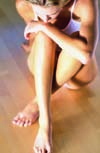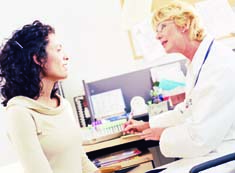What are varicose veins?
Varicose veins are swollen, irregularly shaped veins that most commonly appear in the legs. Varicose veins in the legs affect about one in five adults, and are more common in women.

+ Medical experts suspect that varicose veins are hereditary, although other factors such as hormonal fluctuations and excess weight may impinge on their formation. Varicose veins start when one or more valves fail to close. When valves fail, this allows blood to pool and stretch the veins, further weakening their walls. As the vessels weaken, more and more valves are unable to close properly. The veins become larger and wider over time and begin to appear as lumpy, winding chains underneath the skin.
Different from arteries, veins have valves that make the blood flow toward the heart. A healthy vein has vessels with valves that close to prevent the blood from flowing backward when returning to the heart. In a varicose vein, the vein's wall deteriorates, making the valve incompetent. When the valves stop working blood begins to get stuck, especially when standing. Studies have shown that women are more likely to suffer from varicose veins than men are. Varicose veins affect one in four women in general and one in two women over the age of forty.
CONSEQUENCES
- • Slight: pain, discomfort, swelling and tingling sensation.
- • Moderate: eczema, skin discoloration, and dermatitis.
- • Serious: loss of sensation in the skin, tissue problems and varicose ulcers.
- • Severe: blood clots, severely bulged veins.
BLOOD FLOW
In a healthy vein, the valve openings close to prevent the blood flowing backward. In a varicose vein these valves malfunction, not allowing the flow of blood to reverse properly.

ALERT: BLOOD CLOTS AND RUPTURED VEINS
There are two very serious complications related to varicose veins: blockage (because of blood clots) and ruptured veins. Blood clots are easily noticed, because they tend to be very painful. They have the appearence of tumor like, reddish swellings that don't go down, even when you put your feet up. Ruptured veins are more dangerous, because patients rapidly lose blood. The most sensitive area for ruptured veins is in the ankles. In the case of a ruptured vein, apply pressure to the area to stop the bleeding and go immediately to your doctor's office or hospital.

SYMPTOMS
Blue, swollen, bulging veins or spider veins that are a deep red or purple color are the most visible signs of this ailment. However, sometimes symptoms such as pain and itchiness appear before visible signs of blue veins under the skin. Some people with varicose veins never have any pain or discomfort, just visible symptoms. Varicose veins tend to develop on the inner part of the leg and ankles, especially when the leg is hot. Occasionally, symptoms get worse when varicose veins develop than when they've formed completely.

Comment about this article, ask questions, or add new information about this topic: